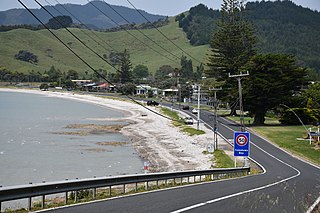Demographics
Kerepehi is defined by Statistics New Zealand as a rural settlement and covers 2.18 km2 (0.84 sq mi). [1] It is part of the wider Hauraki Plains South statistical area.
Historical population for Kerepehi| Year | Pop. | ±% p.a. |
|---|
| 2006 | 486 | — |
|---|
| 2013 | 405 | −2.57% |
|---|
| 2018 | 507 | +4.59% |
|---|
| Source: [2] |
Kerepehi had a population of 507 at the 2018 New Zealand census, an increase of 102 people (25.2%) since the 2013 census, and an increase of 21 people (4.3%) since the 2006 census. There were 186 households, comprising 267 males and 246 females, giving a sex ratio of 1.09 males per female, with 126 people (24.9%) aged under 15 years, 99 (19.5%) aged 15 to 29, 213 (42.0%) aged 30 to 64, and 69 (13.6%) aged 65 or older.
Ethnicities were 72.2% European/Pākehā, 45.6% Māori, 5.3% Pacific peoples, 1.2% Asian, and 1.8% other ethnicities. People may identify with more than one ethnicity.
Although some people chose not to answer the census's question about religious affiliation, 59.2% had no religion, 18.3% were Christian, 8.9% had Māori religious beliefs and 3.0% had other religions.
Of those at least 15 years old, 18 (4.7%) people had a bachelor's or higher degree, and 123 (32.3%) people had no formal qualifications. 21 people (5.5%) earned over $70,000 compared to 17.2% nationally. The employment status of those at least 15 was that 174 (45.7%) people were employed full-time, 54 (14.2%) were part-time, and 21 (5.5%) were unemployed. [2]
Hauraki Plains South
Hauraki Plains South, which also includes Kaihere and Patetonga, covers 251.35 km2 (97.05 sq mi) [1] and had an estimated population of 1,750 as of June 2022, [5] with a population density of 7.0 people per km2.
Historical population for Hauraki Plains South| Year | Pop. | ±% p.a. |
|---|
| 2006 | 1,536 | — |
|---|
| 2013 | 1,395 | −1.37% |
|---|
| 2018 | 1,533 | +1.90% |
|---|
| Source: [6] |
Hauraki Plains South had a population of 1,533 at the 2018 New Zealand census, an increase of 138 people (9.9%) since the 2013 census, and a decrease of 3 people (−0.2%) since the 2006 census. There were 537 households, comprising 783 males and 750 females, giving a sex ratio of 1.04 males per female. The median age was 33.6 years (compared with 37.4 years nationally), with 396 people (25.8%) aged under 15 years, 282 (18.4%) aged 15 to 29, 681 (44.4%) aged 30 to 64, and 174 (11.4%) aged 65 or older.
Ethnicities were 81.2% European/Pākehā, 25.8% Māori, 3.1% Pacific peoples, 4.5% Asian, and 2.0% other ethnicities. People may identify with more than one ethnicity.
The percentage of people born overseas was 11.7, compared with 27.1% nationally.
Although some people chose not to answer the census's question about religious affiliation, 60.1% had no religion, 24.5% were Christian, 3.5% had Māori religious beliefs and 2.5% had other religions.
Of those at least 15 years old, 108 (9.5%) people had a bachelor's or higher degree, and 294 (25.9%) people had no formal qualifications. The median income was $33,000, compared with $31,800 nationally. 132 people (11.6%) earned over $70,000 compared to 17.2% nationally. The employment status of those at least 15 was that 606 (53.3%) people were employed full-time, 180 (15.8%) were part-time, and 33 (2.9%) were unemployed. [6]
This page is based on this
Wikipedia article Text is available under the
CC BY-SA 4.0 license; additional terms may apply.
Images, videos and audio are available under their respective licenses.












